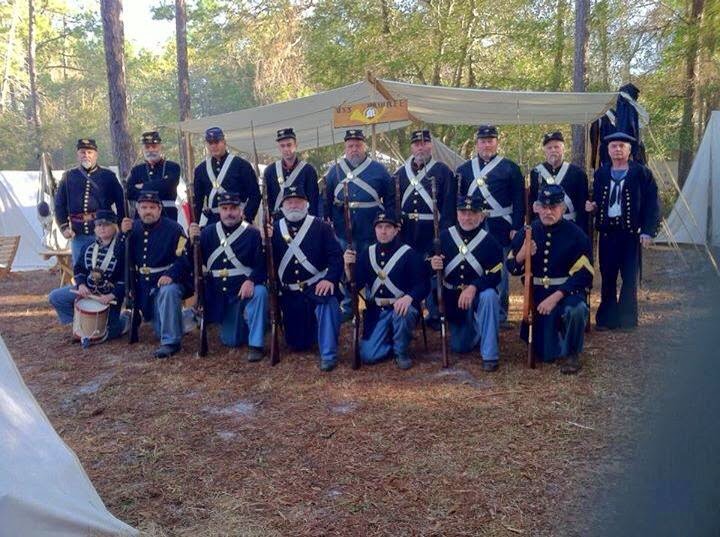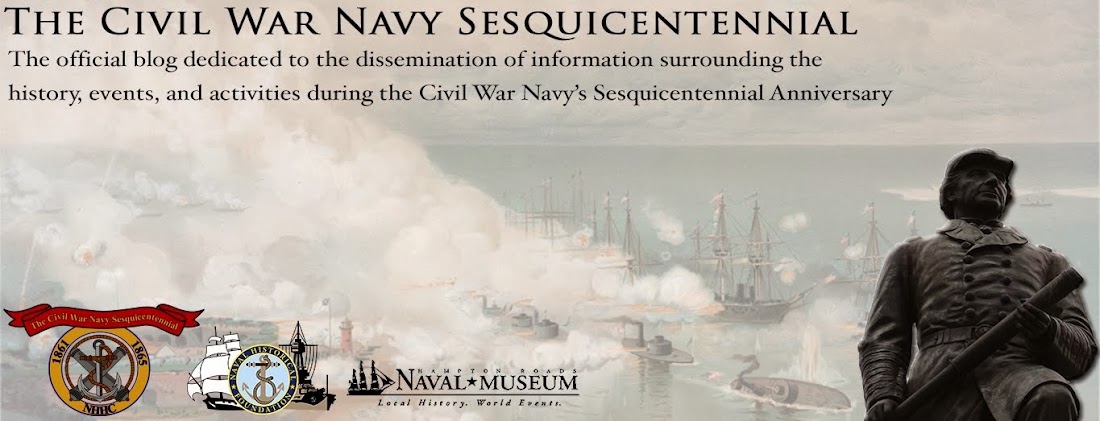As we are at or near the end of the Civil War Navy Sesquicentennial, I would be interested in reading any retrospective posts from current or former contributors to this blog, as well as the many folks who have followed us. Any thoughts after the last five years? I'm sure there are a few out there. I'd also be interested in the thoughts of any naval history scholars.
One of the things that strikes me, and that I frequently mention to folks in my presentations, is that the U.S. Navy was the second most powerful Navy in the world at the end of the CW, but how quickly it deteriorated, or was allowed to deteriorate, after the war. Some shrinkage might be understandable, given the post-war fatigue, need to divert funds to rebuilding, etc., but the lack of technological progress or advancement was mystifying to me, especially based on the lessons learned during the war.
Based on what I have read by other scholars, some of this was a result of the continuing refusal by naval leadership to adapt the emerging naval technologies. While the USN has always been a service steeped in tradition, sometimes dedication to tradition can be debilitating. While the European, and even some of the South American navies began to transition to sea-going, armored warships, the USN continued to use Civil War-era ships and technology well into the 1880's it seems. And only the prospect of war with the Spanish Navy (and potential conflicts with the Germans, as well?) finally galvanized the USN into building up-to-date armored cruisers and battleships. Maybe a new generation of leadership helped as well.
I'm sure there has been much analysis of this elsewhere, and I would most appreciate giving me a "heads up" on interesting articles or books on the post-CW USN and the forces behind what happened.
What posts on this site stood out for you in the last five years? It is hard for me to pick any particular favorites. The material on the War on the Western Rivers was always interesting for me, as I have always tended to focus more on the naval CW along the coasts. Dr. John Grady's posts were always thought-provoking to me, and Sara Adler was our "Monty Python" (. . . and now for something completely different). Comments are welcome.
Sunday, July 12, 2015
Thursday, May 7, 2015
The War is over: but not for the Navy
 |
| Confederate warship CSS Stonewall. Source: Naval History and Heritage Command. |
Gen. Robert E. Lee surrendered his army the month before at Appomattox, and the Confederate western generals not long afterward. Confederate President Jefferson Davis and his cabinet were being arrested as they tried to flee the country. The Union Navy presence off the southern coastline continued, mainly to enforce the peace, help slaves now completely released from their servitude, assist with rebuilding, and other mundane duties. Adm. C.K. Stribling commands the East Gulf Blockading Squadron from his home base at Key West, Florida.
Sometime in early May, the Admiral receives a dispatch from the U.S. Consul General in Havana, Cuba, which incites a panic. The Confederate ocean-going ironclad ram CSS Stonewall has docked at Havana harbor. This warship was built by France, for the Confederate Navy, which eventually took possession of her through a tortuous process. This ship was the "next generation" in blue-water warships. She was powered both by steam and sail rig, heavily armored, and armed with some of the most technologically advanced naval gunnery of the day; a 300-pdr and two 70-pdr Armstrong guns. When she left Portugal in March of 1865, the USN warships Niagara and Sacramento made weak attempts to confront her, but the USN had nothing that could go up against this formidable Confederate warship. It is rumored that she may be headed for Texas, or even perhaps Florida, to where the Confederate cabinet were fleeing, to pick them up and evacuate them to safety.
Stribling no doubt struggled with what to do. Eventually, he dispatched the USS Powhatan, with his Flag Captain aboard, and the USS Aries, followed by the USS Mahaska and Tallapoosa, to blockade the harbor of Havana. The captains of these vessels had orders to engage the Stonewall, should she try to make a run out of the harbor, and fight her to their destruction or the destruction of the Stonewall. It was a suicide mission. Without consulting his superiors, Stribling also sent two dispatches to the U.S. Consul General in Havana. One was delivered to the commanding officer of the Stonewall; an earnest and heartfelt plea to consider that the Confederacy was dead, and to surrender his warship, under terms of parole identical to those granted to Lee and his army. The second dispatch was delivered to the Captain General of the Island of Cuba (the official government representative of the Spanish Crown, who ruled the island). This missive was not as nice; it informed the Capt. General that, because of the collapse of the Confederate government and state, the Stonewall was no longer considered a legitimate ship-of-war, which enjoyed certain protections under international law. She was considered a pirate, and for Cuba to be offering protection would be aiding and abetting piracy, authorizing the U.S. Navy to take whatever actions necessary against the ship and the Island of Cuba to abet this threat.
Stibling's message got through to somebody, somehow. On 19 May, the Stonewall was surrendered to Spanish Naval authorities, and turned over to the U.S. Navy shortly thereafter. The members of the Stonewall's crew were paid off the salary owed them in Spanish gold. For reasons I have still not found out, the USN eventually sold her to the Japanese Navy.
In the last few months of the Civil War (maybe even after it "officially" ended), it is interesting that the last military vestiges of the Confederacy were her Navy. The Stonewall surrendered a month after the essential collapse of the Confederate Army. Six months later, the last Confederate warship, the raider CSS Shenandoah, hauled down her flag in England in November, 1865 and surrendered to those authorities. Maybe this is the legacy of Confederate Navy Secretary Stephen R. Mallory, who built a Navy from scratch, and whose Navy persisted until the end of the War, and even beyond.
| Grave marker of C.S. Navy Secretary Mallory, in Pensacola, Florida. Photo by Tiffany Trent. |
Wednesday, April 15, 2015
The Death of Abraham Lincoln
Yesterday (14 April) and today mark the 150th anniversary of the assassination of President Lincoln by John Wilkes Booth. Here is an interesting illustration, showing Columbia (??) mourning over the President's casket, and in the upper corners, a soldier grieving, representing the sorrow of the Army (on the upper left), and a sailor sobbing into his hands next to his gun, representing the sorrow of the Navy (upper right) for their commander-in-chief.
Thursday, March 12, 2015
Battle of Natural Bridge, Florida. March 1865
 |
| Map of the St. Marks River mouth, showing disposition of Navy gunboats during the landing of troops. Official Records of the Union and Confederate Navies |
In the early days of 1865, with the war starting to wind
down, Union Army General John Newton decided to organize an assault on the
Florida state capitol, Tallahassee. He would land his troops at St. Marks and
march northward to the city. Perhaps some of his motivation was to try to
avenge the stinging defeat the Union Army had suffered a year earlier at
Olustee.
A joint Army/Navy task force began to land Union troops
near the lighthouse at the mouth of the St. Marks River on 3 March 1865. Heavy
weather hampered the operations, but all forces were landed by 5 March 1865.
Assisting in the operation were the Union Navy gunboats Stars and Stripes, Fort Henry,
Mahaska, Honduras, Hibiscus, and Britannia. Landing parties of sailors
and marines were also put ashore to capture critical bridges and occupy
Confederate forces at St. Marks to prevent their interfering with the Union
Army advance.
 |
| USS Hibiscus. Naval History and Heritage Command |
The Union forces were landed on the east side of the St.
Marks River, which meant they had to cross the river to advance on Tallahassee.
The Confederates burned a bridge over the river at Newport, which forced the
Union troops to head northward to cross the St. Marks River at a “natural
bridge” feature where it dips underground for a stretch. The Union column was
met at this feature by a rag-tag Confederate defense consisting of soldiers on
leave, local militia, and cadets from the West Florida Seminary (now Florida
State University) on 6 March 1865. Supported by several pieces of artillery,
the Confederate force repulsed multiple advances by the Union forces, who
ultimately withdrew back to their landing at the mouth of the river and were
evacuated by the Navy gunboats. The “Battle of Natural Bridge” was the second
largest land engagement in Florida after Olustee, and the result was the same; yet
another Union defeat. Tallahassee became the only Confederate state capitol
east of the Mississippi River that was not taken by the Union during the war.
The weekend of 7-8
March 2015, the 38th reenactment of the Battle of Natural Bridge was held at
the Natural Bridge Battlefield Historic State Park (the site of the original
battle). This was a special event, as it commemorated the 150th Anniversary of
the battle. Reenactors from the USS Pawnee
Guard marines and USS Ft. Henry
Living History Association portrayed a naval landing party and, as they did in
the original engagement, provided flanking cover to the Union Army advance on
the battlefield.
 |
| Members of the Pawnee Guard (US Marines) and a sailor with the USS Ft. Henry Living History Association in camp at the Natural Bridge battle reenactment in March 2015. Courtesy Pawnee Guard. |
Friday, January 2, 2015
New Book by CWN150 Contributing Blogger Seaman Rob
 |
| Photo by Mat O'Malley |
At the risk of engaging in "shameless self-promotion," I would like to let you all know about a book that I have recently self-published. It is titled "The Civil War Navy in Florida" and is based largely on the posts I have been contributing to this Blog for the past 5 years or so.
It covers the actions and activities of the Union and Confederate Navies in Florida during the Civil War and I hope you will enjoy it should you decide to get a copy. It is available through your local independent bookseller and through Amazon.com and BarnesandNoble.com. Thanks so much again for your interest and attention over these last five years.
Subscribe to:
Posts (Atom)


